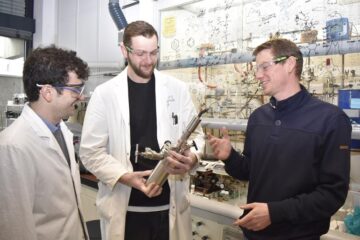Interplanetary networking: ESA’s Mars Express will keep an eye on NASA’s Phoenix

Phoenix’s launch is scheduled for 4 August this year and it is expected to land on the Red Planet in the spring of 2008. The mission will investigate the Martian environment and will look beneath the frigid, arctic landscape in search of conditions favourable to past or present life. At NASA’s request, ESA’s Mars Express spacecraft will be following Phoenix’s Entry Descent and Landing (EDL) phase.
The critical part of the descent lasts about 13 minutes. During this time, the probe will transmit a continuous stream of information to two of NASA’s satellites already orbiting the Red Planet. To be on the safe side, NASA has requested Mars Express, which has been in orbit around Mars since December 2003, to also monitor the EDL phase.
Mars Express has been selected since, in principle, its elliptical orbit makes it possible for the spacecraft to have a continuous view of the lander and to communicate with it for longer periods of time.
Mars Express will optimise its orbit so that Phoenix is continuously in view during the EDL phase. The final orbit adjustment required for Mars Express will be determined a few weeks after the launch of Phoenix. Final adjustments will be made in April next year, just before the Phoenix EDL phase.
ESA’s Mars Express Mission Manager, Fred Jansen explains, “One of the instruments on board Mars Express is the Mars Express Lander Communications system (MELACOM), designed to communicate with probes on the planet’s surface. Originally meant for communicating with the Beagle 2 lander, which was unfortunately lost, we can now use it to communicate with Phoenix.”
It is possible that the spacecraft will communicate with the lander, not only during EDL, but also for the remainder of the anticipated 90-day lifetime of the mission.
“NASA still has two other active probes on the Martian surface. When Phoenix joins the fleet around mid-2008, lots of data will have to be relayed back to Earth from the surface of Mars. If we are asked to help out by channelling part of the communication through Mars Express, we will, of course, try to accomodate such a request” adds Jansen.
Apart from assistance during the EDL phase, NASA has also requested ESA to support the launch of Phoenix from its ground station in Kourou, French Guiana.
Media Contact
More Information:
http://www.esa.int/SPECIALS/Mars_Express/SEMWNCWUP4F_0.htmlAll latest news from the category: Physics and Astronomy
This area deals with the fundamental laws and building blocks of nature and how they interact, the properties and the behavior of matter, and research into space and time and their structures.
innovations-report provides in-depth reports and articles on subjects such as astrophysics, laser technologies, nuclear, quantum, particle and solid-state physics, nanotechnologies, planetary research and findings (Mars, Venus) and developments related to the Hubble Telescope.
Newest articles

Lower dose of mpox vaccine is safe
… and generates six-week antibody response equivalent to standard regimen. Study highlights need for defined markers of mpox immunity to inform public health use. A dose-sparing intradermal mpox vaccination regimen…

Efficient, sustainable and cost-effective hybrid energy storage system for modern power grids
EU project HyFlow: Over three years of research, the consortium of the EU project HyFlow has successfully developed a highly efficient, sustainable, and cost-effective hybrid energy storage system (HESS) that…

Safer alternative for an explosive reaction
The chemical industry has been using a reaction with explosive chemicals for over 100 years – now Mülheim scientists have discovered a safer alternative. The Ritter Group of the Max…





















